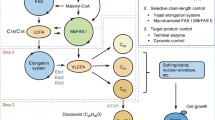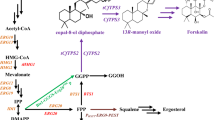Abstract
Triacetic acid lactone (TAL) is a potential platform chemical that can be produced in yeast. To evaluate the potential for industrial yeast strains to produce TAL, the g2ps1 gene encoding 2-pyrone synthase was transformed into 13 industrial yeast strains of varied genetic background. TAL production varied 63-fold between strains when compared in batch culture with glucose. Ethanol, acetate, and glycerol were also tested as potential carbon sources. Batch cultures with ethanol medium produced the highest titers. Therefore, fed-batch cultivation with ethanol feed was assayed for TAL production in bioreactors, producing our highest TAL titer, 5.2 g/L. Higher feed rates resulted in a loss of TAL and subsequent production of additional TAL side products. Finally, TAL efflux was measured and TAL is actively exported from S. cerevisiae cells. Percent yield for all strains was low, indicating that further metabolic engineering of the strains is required.






Similar content being viewed by others
References
Abaecherli C, Miller RJ (2000) Ketenes, ketene dimers, and related substances. In: Kroschwitz JI, Howe-Grant M (eds) Kirk–Othmer encyclopedia of chemical technology. 4th edn. Wiley. doi:10.1002/0471238961.1105200501020105.a01
Achkar J, Xian M, Zhao H, Frost JW (2005) Biosynthesis of phloroglucinol. J Am Chem Soc 127(15):5332–5333. doi:10.1021/ja042340g
Bera AK, Ho NW, Khan A, Sedlak M (2011) A genetic overhaul of Saccharomyces cerevisiae 424A(LNH-ST) to improve xylose fermentation. J Ind Microbiol Biot 38(5):617–626. doi:10.1007/s10295-010-0806-6
Borneman AR, Desany BA, Riches D, Affourtit JP, Forgan AH, Pretorius IS, Egholm M, Chambers PJ (2011) Whole-genome comparison reveals novel genetic elements that characterize the genome of industrial strains of Saccharomyces cerevisiae. PLoS Genet 7(2):e1001287. doi:10.1371/journal.pgen.1001287
Borneman AR, Forgan AH, Pretorius IS, Chambers PJ (2008) Comparative genome analysis of a Saccharomyces cerevisiae wine strain. FEMS Yeast Res 8(7):1185–1195. doi:10.1111/j.1567-1364.2008.00434.x
Brat D, Boles E, Wiedemann B (2009) Functional expression of a bacterial xylose isomerase in Saccharomyces cerevisiae. Appl Environ Microbiol 75(8):2304–2311. doi:10.1128/AEM.02522-08
Cardenas J, Da Silva NA (2014) Metabolic engineering of Saccharomyces cerevisiae for the production of triacetic acid lactone. Metab Eng 25:194–203. doi:10.1016/j.ymben.2014.07.008
Chen B, Ling H, Chang MW (2013) Transporter engineering for improved tolerance against alkane biofuels in Saccharomyces cerevisiae. Biotechnol Biofuels 6(1):21. doi:10.1186/1754-6834-6-21
Chen Y, Daviet L, Schalk M, Siewers V, Nielsen J (2013) Establishing a platform cell factory through engineering of yeast acetyl-CoA metabolism. Metab Eng 15:48–54. doi:10.1016/j.ymben.2012.11.002
Chia M, Schwartz TJ, Shanks BH, Dumesic JA (2012) Triacetic acid lactone as a potential biorenewable platform chemical. Green Chem 14(7):1850–1853. doi:10.1039/C2gc35343a
de Jong-Gubbels P, van den Berg MA, Luttik MA, Steensma HY, van Dijken JP, Pronk JT (1998) Overproduction of acetyl-coenzyme A synthetase isoenzymes in respiring Saccharomyces cerevisiae cells does not reduce acetate production after exposure to glucose excess. FEMS Microbiol Lett 165(1):15–20 pii: S0378-1097(98)00249-3
de Jong-Gubbels P, Vanrolleghem P, Heijnen S, van Dijken JP, Pronk JT (1995) Regulation of carbon metabolism in chemostat cultures of Saccharomyces cerevisiae grown on mixtures of glucose and ethanol. Yeast 11(5):407–418. doi:10.1002/yea.320110503
Demeke MM, Dietz H, Li Y, Foulquie-Moreno MR, Mutturi S, Deprez S, Den Abt T, Bonini BM, Liden G, Dumortier F, Verplaetse A, Boles E, Thevelein JM (2013) Development of a d-xylose fermenting and inhibitor tolerant industrial Saccharomyces cerevisiae strain with high performance in lignocellulose hydrolysates using metabolic and evolutionary engineering. Biotechnol Biofuels 6(1):89. doi:10.1186/1754-6834-6-89
Demeke MM, Dumortier F, Li Y, Broeckx T, Foulquie-Moreno MR, Thevelein JM (2013) Combining inhibitor tolerance and D-xylose fermentation in industrial Saccharomyces cerevisiae for efficient lignocellulose-based bioethanol production. Biotechnol Biofuels 6(1):120. doi:10.1186/1754-6834-6-120
Dunlop MJ, Dossani ZY, Szmidt HL, Chu HC, Lee TS, Keasling JD, Hadi MZ, Mukhopadhyay A (2011) Engineering microbial biofuel tolerance and export using efflux pumps. Mol Syst Biol 7:487. doi:10.1038/msb.2011.21
Eckermann S, Schroder G, Schmidt J, Strack D, Edrada RA, Helariutta Y, Elomaa P, Kotilainen M, Kilpelainen I, Proksch P, Teeri TH, Schroder J (1998) New pathway to polyketides in plants. Nature 396(6709):387–390. doi:10.1038/24652
Fersht A (1999) Structure and mechanism in protein science: a guide to enzyme catalysis and protein folding. W.H. Freeman and Company, New York, pp 132–168
Garcia Sanchez R, Karhumaa K, Fonseca C, Sanchez Nogue V, Almeida JR, Larsson CU, Bengtsson O, Bettiga M, Hahn-Hägerdal B, Gorwa-Grauslund MF (2010) Improved xylose and arabinose utilization by an industrial recombinant Saccharomyces cerevisiae strain using evolutionary engineering. Biotechnol Biofuels 3:13. doi:10.1186/1754-6834-3-13
Gietz D, Woods RA (2002) Transformation of yeasts by the lithium acetate/single-stranded carrier/polyethylene glycol method. Methods Enzymol 350:87–96. doi:10.1016/S0076-6879(02)50957-5
Gombert AK, Moreira dos Santos M, Christensen B, Nielsen J (2001) Network identification and flux quantification in the central metabolism of Saccharomyces cerevisiae under different conditions of glucose repression. J Bacteriol 183(4):1441–1451. doi:10.1128/JB.183.4.1441-1451.2001
Hansen CA, Frost JW (2001) Deoxygenation of polyhydroxybenzenes: an alternative strategy for the benzene-free synthesis of aromatic chemicals. J Am Chem Soc 124:5926–5927. doi:10.1021/ja0176346
Hector RE, Dien BS, Cotta MA, Qureshi N (2011) Engineering industrial Saccharomyces cerevisiae strains for xylose fermentation and comparison for switchgrass conversion. J Ind Microbiol Biotechnol 38(9):1193–1202. doi:10.1007/s10295-010-0896-1
Jorgensen P, Nishikawa JL, Breitkreutz BJ, Tyers M (2002) Systematic identification of pathways that couple cell growth and division in yeast. Science 297(5580):395–400. doi:10.1126/science.1070850
Klis FM, de Koster CG, Brul S (2014) Cell wall-related bionumbers and bioestimates of Saccharomyces cerevisiae and Candida albicans. Eukaryot Cell 13(1):2–9. doi:10.1128/EC.00250-13
Kozak BU, van Rossum HM, Benjamin KR, Wu L, Daran J-MG, Pronk JT, van Maris AJA (2014) Replacement of the Saccharomyces cerevisiae acetyl-CoA synthetases by alternative pathways for cytosolic acetyl-CoA synthesis. Metab Eng 21:46–59. doi:10.1016/j.ymben.2013.11.005
Krivoruchko A, Serrano-Amatriain C, Chen Y, Siewers V, Nielsen J (2013) Improving biobutanol production in engineered Saccharomyces cerevisiae by manipulation of acetyl-CoA metabolism. J Ind Microbiol Biotechnol 40(9):1051–1056. doi:10.1007/s10295-013-1296-0
Lian J, Si T, Nair NU, Zhao H (2014) Design and construction of acetyl-CoA overproducing Saccharomyces cerevisiae strains. Metab Eng. doi:10.1016/j.ymben.2014.05.010
Modig T, Almeida JR, Gorwa-Grauslund MF, Liden G (2008) Variability of the response of Saccharomyces cerevisiae strains to lignocellulose hydrolysate. Biotechnol Bioeng 100(3):423–429. doi:10.1002/bit.21789
Nikolau BJ, Perera MADN, Brachova L, Shanks B (2008) Platform biochemicals for a biorenewable chemical industry. Plant J 54(4):536–545. doi:10.1111/j.1365-313X.2008.03484.x
Paddon CJ, Keasling JD (2014) Semi-synthetic artemisinin: a model for the use of synthetic biology in pharmaceutical development. Nat Rev Microbiol. doi:10.1038/nrmicro3240
Paddon CJ, Westfall PJ, Pitera DJ, Benjamin K, Fisher K, McPhee D, Leavell MD, Tai A, Main A, Eng D, Polichuk DR, Teoh KH, Reed DW, Treynor T, Lenihan J, Fleck M, Bajad S, Dang G, Dengrove D, Diola D, Dorin G, Ellens KW, Fickes S, Galazzo J, Gaucher SP, Geistlinger T, Henry R, Hepp M, Horning T, Iqbal T, Jiang H, Kizer L, Lieu B, Melis D, Moss N, Regentin R, Secrest S, Tsuruta H, Vazquez R, Westblade LF, Xu L, Yu M, Zhang Y, Zhao L, Lievense J, Covello PS, Keasling JD, Reiling KK, Renninger NS, Newman JD (2013) High-level semi-synthetic production of the potent antimalarial artemisinin. Nature 496(7446):528–532. doi:10.1038/nature12051
Papini M, Nookaew I, Uhlen M, Nielsen J (2012) Scheffersomyces stipitis: a comparative systems biology study with the Crabtree positive yeast Saccharomyces cerevisiae. Microb Cell Fact 11:136. doi:10.1186/1475-2859-11-136
Pereira FB, Romani A, Ruiz HA, Teixeira JA, Domingues L (2014) Industrial robust yeast isolates with great potential for fermentation of lignocellulosic biomass. Bioresour Technol 161C:192–199. doi:10.1016/j.biortech.2014.03.043
Piper P, Calderon CO, Hatzixanthis K, Mollapour M (2001) Weak acid adaptation: the stress response that confers yeasts with resistance to organic acid food preservatives. Microbiology 147:2635–2642
Pronk JT, Yde Steensma H, Van Dijken JP (1996) Pyruvate metabolism in Saccharomyces cerevisiae. Yeast 12(16):1607–1633. doi:10.1002/(SICI)1097-0061(199612)12:16<1607:AID-YEA70>3.0.CO;2-4
Remize F, Andrieu E, Dequin S (2000) Engineering of the pyruvate dehydrogenase bypass in Saccharomyces cerevisiae: role of the cytosolic Mg(2+) and mitochondrial K(+) acetaldehyde dehydrogenases Ald6p and Ald4p in acetate formation during alcoholic fermentation. Appl Environ Microbiol 66(8):3151–3159
Reyes LH, Almario MP, Kao KC (2011) Genomic library screens for genes involved in n-butanol tolerance in Escherichia coli. PLoS ONE 6(3):e17678. doi:10.1371/journal.pone.0017678
Richardson MT, Pohl NL, Kealey JT, Khosla C (1999) Tolerance and Specificity of recombinant 6-methylsalicylic acid synthase. Metab Eng 1:180–187. doi:10.1006/mben.1999.0113
Sa-Correia I, dos Santos SC, Teixeira MC, Cabrito TR, Mira NP (2009) Drug: H+ antiporters in chemical stress response in yeast. Trends Microbiol 17(1):22–31. doi:10.1016/j.tim.2008.09.007
Sambrook J, Russell DW (2001) Molecular cloning: a laboratory manual, 3rd edn. Cold Spring Harbor Laboratory Press, Cold Spring Harbor
Sikorski RS, Hieter P (1989) A system of shuttle vectors and yeast host strains designed for efficient manipulation of DNA in Saccharomyces cerevisiae. Genetics 122:19–27
Stambuk BU, Dunn B, Alves SL Jr, Duval EH, Sherlock G (2009) Industrial fuel ethanol yeasts contain adaptive copy number changes in genes involved in vitamin B1 and B6 biosynthesis. Genome Res 19(12):2271–2278. doi:10.1101/gr.094276.109
Steiner S, Philippsen P (1994) Sequence and promoter analysis of the highly expressed TEF gene of the filamentous fungus Ashbya gossypii. Mol Gen Genet 242(3):263–271
Swinnen S, Klein M, Carrillo M, McInnes J, Nguyen HTT, Nevoigt E (2013) Re-evaluation of glycerol utilization in Saccharomyces cerevisiae: characterization of an isolate that grows on glycerol without supporting supplements. Biotechnol Biofuels 6:157. doi:10.1186/1754-6834-6-157
Tang SY, Qian S, Akinterinwa O, Frei CS, Gredell JA, Cirino PC (2013) Screening for enhanced triacetic acid lactone production by recombinant Escherichia coli expressing a designed triacetic acid lactone reporter. J Am Chem Soc 135(27):10099–10103. doi:10.1021/ja402654z
Tenreiro S, Nunes PA, Viegas CA, Neves MS, Teixeira MC, Cabral MG, Sa-Correia I (2002) AQR1 gene (ORF YNL065w) encodes a plasma membrane transporter of the major facilitator superfamily that confers resistance to short-chain monocarboxylic acids and quinidine in Saccharomyces cerevisiae. Biochem Biophys Res Commun 292(3):741–748. doi:10.1006/bbrc.2002.6703
Westfall PJ, Pitera DJ, Lenihan JR, Eng D, Woolard FX, Regentin R, Horning T, Tsuruta H, Melis DJ, Owens A, Fickes S, Diola D, Benjamin KR, Keasling JD, Leavell MD, McPhee DJ, Renninger NS, Newman JD, Paddon CJ (2012) Production of amorphadiene in yeast, and its conversion to dihydroartemisinic acid, precursor to the antimalarial agent artemisinin. Proc Natl Acad Sci USA 109(3):E111–E118. doi:10.1073/pnas.1110740109
Wohlbach DJ, Rovinskiy N, Lewis JA, Sardi M, Schackwitz WS, Martin JA, Deshpande S, Daum CG, Lipzen A, Sato TK, Gasch AP (2014) Comparative genomics of Saccharomyces cerevisiae natural isolates for bioenergy production. Genome Biol Evol. doi:10.1093/gbe/evu199
Xie D, Shao Z, Achkar J, Zha W, Frost JW, Zhao H (2006) Microbial synthesis of triacetic acid lactone. Biotechnol Bioeng 93(4):727–736. doi:10.1002/bit.20759
Zha W, Shao Z, Frost JW, Zhao H (2004) Rational pathway engineering of type I fatty acid synthase allows the biosynthesis of triacetic acid lactone from d-glucose in vivo. J Am Chem Soc 126(14):4534–4535. doi:10.1021/ja0317271
Acknowledgments
We thank Katherine Card for her excellent technical assistance throughout this study. The authors would also like to thank Dr. Joseph Noel (Salk Institute) for the g2ps1 gene encoding the 2-pyrone synthase.
Conflict of interest
The authors declare no conflict of interest.
Author information
Authors and Affiliations
Corresponding author
Additional information
Mention of trade names or commercial products in this article is solely for the purpose of providing scientific information and does not imply recommendation or endorsement by the U.S. Department of Agriculture. USDA is an equal opportunity provider and employer.
Electronic supplementary material
Below is the link to the electronic supplementary material.
Rights and permissions
About this article
Cite this article
Saunders, L.P., Bowman, M.J., Mertens, J.A. et al. Triacetic acid lactone production in industrial Saccharomyces yeast strains. J Ind Microbiol Biotechnol 42, 711–721 (2015). https://doi.org/10.1007/s10295-015-1596-7
Received:
Accepted:
Published:
Issue Date:
DOI: https://doi.org/10.1007/s10295-015-1596-7




